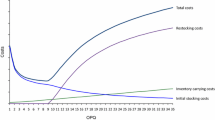Abstract
Shelf stacking represents the daily process of manually refilling the shelves with products from new deliveries. For most retailers, handling operations are labour-intensive and often very costly. This paper presents an empirical study of the shelf-stacking process in grocery retail stores. We examine the complete process at the level of individual sub-activities and study the main factors that affect the execution time of this common operation. Based on the insights from different sub-activities, a prediction model is developed that allows estimating the total stacking time per order line, solely on the basis of the number of case packs and consumer units. The model is tested and validated using real-life data from two European grocery retailers and serves as a useful tool for evaluating the workload required for the usual shelf-stacking operations. Furthermore, we illustrate the benefits of the model by analytically quantifying the potential time savings in the stacking process, and present a lot-sizing analysis to demonstrate the opportunities for extending inventory control rules with a handling component.


Similar content being viewed by others
References
Aiken LS and West SG (1991). Multiple Regression: Testing and Interpreting Interactions. Sage Publications: London.
Atchley WR, Gaskins CT and Anderson D (1976). Statistical properties of ratios. I. Empirical results. Syst Zool 25: 137–148.
Barnes RM (1968). Motion and Time Study Design and Measurement of Work. John Wiley & Son: New York.
Berges JA (1997). Ratios, regression statistics, and ‘spurious' correlations. Limnol Oceanogr 42: 1006–1007.
Broekmeulen R, van Donselaar K, Fransoo J and van Woensel T (2004). Excess shelf space in retail stores: An analytical model and empirical assessment. BETA Working Paper 109, Technische Universiteit Eindhoven, Eindhoven.
Butner K (2005). The GMA 2005 Logistics Survey: Supply chain performance in food, grocery and consumer product. IBM Institute for Business Value Study, January 2005.
Cachon G (2001). Managing a retailer's shelf space, inventory, and transportation. Manuf Serv Oper Mngt 3: 211–229.
Chain Store Age (1963). Cifrino's space yield formula: A breakthrough for measuring product profit, Vol. 39: 11, Lebhar-Friedman Inc: New York.
Chain Store Age (1965). Shelf allocation breakthrough, Vol. 41, pp 77–88, Lebhar-Friedman Inc: New York.
Corstjens M and Doyle P (1981). A model for optimizing retail shelf space allocations. Mngt Sci 27: 822–833.
Drèze X, Hoch SJ and Purk ME (1994). Shelf management and space elasticity. J Retailing 70: 301–326.
DULOG (1997). Handling Costs in the Swedish Grocery Retail Industry. DULOG: Dagligvaruhandlarnas Utvecklings och Logistikgrupp, Stockholm, Sweden.
Gray CF (1992). An integrated methodology for dynamic labour productivity standards, performance control, and system audit in warehouse operations. Prod Invent Mngt J 33: 63–67.
Gray AE, Karmarkar US and Seidmann A (1992). Design and operation of an order-consolidation warehouse: Models and application. Eur J Opl Res 58: 14–36.
Gujarati DN (1995). Basic Econometrics, 3rd edn.. McGraw-Hill: Singapore.
Hellström D and Saghir M (2007). Packaging and logistics interactions in retail supply chains. Packag Technol Sci 20: 197–216.
Hoare NP and Beasley JE (2001). Placing boxes on shelves: A case study. J Opl Res Soc 52: 605–614.
Kaplan RS and Anderson SR (2004). Time-driven activity-based costing. Harward Bus Rev 83(11): 131–138.
Levy M and Weitz BA (2001). Retailing Management. Irqwin: Chicago.
Niebel BW (1993). Motion and Time Study. Irwin Inc.: Homewood: IL.
Rouwenhorst B, Reuter B, Stockrahm V, van Houtum GJ, Mantel RJ and Zijm WHM (2000). Warehouse design and control: Framework and literature review. Eur J Opl Res 122: 515–533.
Saghir M and Jönson G (2001). Packaging handling evaluation methods in the grocery retail industry. Packag Technol Sci 14: 21–29.
Themido I, Arantes A, Fernandes C and Guedes AP (2000). Logistics costs case study—An ABC approach. J Opl Res Soc 51: 1148–1157.
Tompkins JA, White JA, Bozer YA and Tanchoco JMA (2003). Facilities Planning, 2nd edn.. John Wiley & Sons: New York.
Urban TL (1998). An inventory-theoretic approach to product assortment and shelf-space allocation. J Retailing 74(1): 15–35.
Van Zelst S, Van Donselaar K, Van Woensel T, Broekmeulen R and Fransoo J (2006). Logistics drivers for shelf stacking in grocery retail stores: Potential for efficiency improvement. Int J Prod Econ, doi:10.1016/j.ijpe.2006.06.010.
Varila M, Seppänen M and Suomala P (2007). Detailed cost modelling: a case study in warehouse logistics. Int J Phys Distrib Logist Mngt 37(3): 184–200.
Wang GCS (1994). What should you know about regression based forecasting. J Bus Forecast Meth Syst 12(4): 15–21.
Author information
Authors and Affiliations
Corresponding author
Appendices
Appendix A
See Table A1.
Appendix B. Descriptive statistics of the empirical datasets
Appendix C. Validation of results for chain B
Rights and permissions
About this article
Cite this article
Curşeu, A., van Woensel, T., Fransoo, J. et al. Modelling handling operations in grocery retail stores: an empirical analysis. J Oper Res Soc 60, 200–214 (2009). https://doi.org/10.1057/palgrave.jors.2602553
Received:
Accepted:
Published:
Issue Date:
DOI: https://doi.org/10.1057/palgrave.jors.2602553




